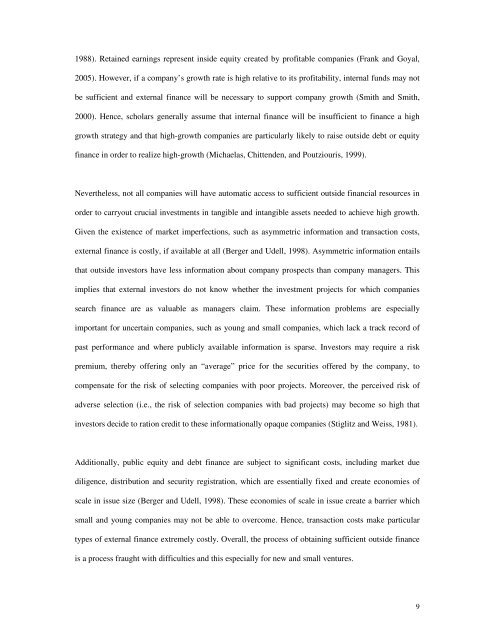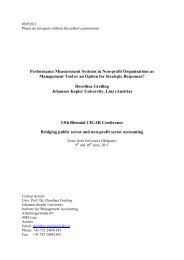Financing Unquoted High-Growth Companies: From Extending
Financing Unquoted High-Growth Companies: From Extending
Financing Unquoted High-Growth Companies: From Extending
Create successful ePaper yourself
Turn your PDF publications into a flip-book with our unique Google optimized e-Paper software.
1988). Retained earnings represent inside equity created by profitable companies (Frank and Goyal,<br />
2005). However, if a company’s growth rate is high relative to its profitability, internal funds may not<br />
be sufficient and external finance will be necessary to support company growth (Smith and Smith,<br />
2000). Hence, scholars generally assume that internal finance will be insufficient to finance a high<br />
growth strategy and that high-growth companies are particularly likely to raise outside debt or equity<br />
finance in order to realize high-growth (Michaelas, Chittenden, and Poutziouris, 1999).<br />
Nevertheless, not all companies will have automatic access to sufficient outside financial resources in<br />
order to carryout crucial investments in tangible and intangible assets needed to achieve high growth.<br />
Given the existence of market imperfections, such as asymmetric information and transaction costs,<br />
external finance is costly, if available at all (Berger and Udell, 1998). Asymmetric information entails<br />
that outside investors have less information about company prospects than company managers. This<br />
implies that external investors do not know whether the investment projects for which companies<br />
search finance are as valuable as managers claim. These information problems are especially<br />
important for uncertain companies, such as young and small companies, which lack a track record of<br />
past performance and where publicly available information is sparse. Investors may require a risk<br />
premium, thereby offering only an “average” price for the securities offered by the company, to<br />
compensate for the risk of selecting companies with poor projects. Moreover, the perceived risk of<br />
adverse selection (i.e., the risk of selection companies with bad projects) may become so high that<br />
investors decide to ration credit to these informationally opaque companies (Stiglitz and Weiss, 1981).<br />
Additionally, public equity and debt finance are subject to significant costs, including market due<br />
diligence, distribution and security registration, which are essentially fixed and create economies of<br />
scale in issue size (Berger and Udell, 1998). These economies of scale in issue create a barrier which<br />
small and young companies may not be able to overcome. Hence, transaction costs make particular<br />
types of external finance extremely costly. Overall, the process of obtaining sufficient outside finance<br />
is a process fraught with difficulties and this especially for new and small ventures.<br />
9

















